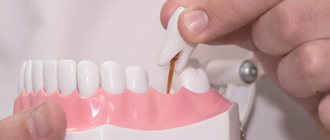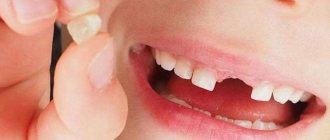- Crooked teeth
- The appearance of a second row of teeth in the jaw
- When permanent teeth do not appear for a long time
- How to distinguish baby teeth from permanent ones?
The complex process of replacing baby teeth with permanent ones is often painful and accompanied by a number of problems. The most common of them is malocclusion. The second most common problem is the appearance of a second set of teeth. Also, many parents are faced with the fact that their child’s molars and incisors do not appear for a very long time.
Crooked teeth
If permanent teeth begin to grow unevenly, you need to come for a consultation with an orthodontist at the A-Medic Network of Medical Clinics as soon as possible. The sooner such a decision is made, the easier it will be for the dentist to correct their growth. An incorrect bite is not only inconvenient, it can lead to the development of a number of diseases, for example, caries, stomach diseases, and cause childhood and teenage complexes and psychological problems.
The easiest way to straighten your jaw is to wear braces. It is very important for parents, together with the attending physician, to explain to the child that temporary inconveniences when using braces are justified and will bring invaluable benefits in the future. You need to take good care of it, because it will stay in your mouth for at least six months. This design will work most effectively during adolescence. Small children can more easily tolerate plates or trainers, which look something like boxing mouthguards, rather than braces. Children's enamel is quite delicate, so trainers that do not damage it will be the best way to correct a child's malocclusion.
A child’s teeth deteriorate: reasons
The most common problems with children's teeth identified by dentists are:
- the baby’s teeth turn black or the enamel darkens in places;
- the child has fragile teeth, which is why they begin to crumble;
- active development of caries in preschool children.
Let's look at the causes of these key problems and possible ways to solve them.
A child's teeth deteriorate for various reasons. The main ones:
- exposure to aggravating factors during the period of intrauterine development of the fetus (severe and prolonged toxicosis during pregnancy, impaired or insufficient nutrition of the expectant mother, necessary or careless use of certain medications);
- if a baby under the age of one year was given intensive antibiotic therapy;
- insufficient dental care and, as a consequence, the development of early caries;
- insufficient absorption of calcium;
- permanent and persistent dental plaque;
- hereditary predisposition (individual characteristics of enamel);
- limited salivation;
- chronic diseases. For example, gastritis with high acidity makes tooth enamel more susceptible to caries. This is explained by the fact that increased acidity affects the absorption of calcium and phosphorus;
- dysbacteriosis;
- the presence of a large amount of foods and drinks containing sugar in the child’s diet;
- impaired metabolism;
- exchange of bacteria between parents and child (for example, when sharing cutlery);
- unformed children's enamel.
Dark spots on the enamel may indicate that caries has begun to develop. If you start this process, caries will penetrate even deeper into the tooth. Due to the special structure of the pulp, destructive processes spread very quickly: for example, caries can turn into pulpitis in just a few months.
The appearance of a second row of teeth in the jaw
Each canine, incisor and molar has its own place, but sometimes a child's permanent teeth begin to form a second row. This often happens when the milky ones have not yet fallen out, but the radical ones have already begun to appear. An undeveloped jaw that provides too little room for growth can also be a source of the problem. The third reason is that the incisors and canines in the second row are “superfluous”, or supernumerary.
The second row of teeth is not only inconvenient, but also unsightly, so the problem needs to be solved. A baby tooth that does not fall out in time can be removed in the clinic. If the reason for the formation of the second row is underdevelopment of the jaw, then the dentist can remove several teeth and install braces on the remaining ones.
When do the first teeth usually appear?
There is a so-called scheme for the eruption of baby teeth, which is only conditional. The chronological framework was designated by specialists based on average values, i.e. without taking into account the individual characteristics of the child. According to the general scheme, teeth erupt as follows:
- The lower central incisors appear at 6-7 months
- Upper central incisors - at 8-9 months
- Upper lateral incisors - at 9-11 months
- Lower lateral incisors - at 11-13 months
- Upper and lower first molars - at 12-15 months
- Fangs - at 18-20 months
- Second molars - up to 30 months
You can rely on this scheme, but you shouldn’t emulate it. Dentists and pediatricians admit that some children may begin to erupt their first teeth only by 9 months, and this is normal. In girls, as a rule, this process occurs a little earlier than in boys.
Sometimes, due to individual characteristics, teeth begin to cut later, but soon new ones appear at a high speed, and by a certain age the child can already boast of two rows of snow-white teeth. Typically, by the age of 3, all 20 teeth have erupted.
When permanent teeth do not appear for a long time
The absence of permanent teeth for too long can be due to several reasons: these are the genetic characteristics of the body, their immaturity, and the destruction of tooth germs by some kind of infection.
Only a dentist can determine the true cause. At the A-Medic Network of Medical Clinics clinic, they will take a picture of the jaw, which will show how the child’s permanent teeth are formed. Sometimes they can grow inside the gums. If nothing is visible on the image, the doctor may suggest solving the problem by installing dentures.
If a child’s teeth are spoiling, what to do?
It is important for parents to understand that enamel is the main protection, the stability and structure of which depends on hereditary factors and on the saliva that washes the surface of the teeth. If the composition of saliva is disturbed because the child does not receive enough vital nutrients and minerals, this can lead to the formation of permanent plaque on the teeth. Even with systematic and thorough cleaning, it is impossible to get rid of such plaque forever, since it will appear again and again.
If a child’s teeth deteriorate due to the disturbed composition of saliva, then this problem can be solved by adjusting the diet. The menu should be balanced. It must contain foods rich in iron, calcium and other minerals that strengthen tooth enamel: hard cheese, sesame seeds, bran, feta cheese, milk, cottage cheese, herbs, legumes. Foods rich in phosphorus are very useful: fish, cottage cheese, cod liver, shrimp, squid, beets, carrots.
However, parents’ independent actions cannot always bring results. If your child’s teeth continue to deteriorate, then it is worth making an appointment with a pediatric dentist, who will offer effective treatment methods and help stop the destructive process.
How to distinguish baby teeth from permanent ones?
Both molars and baby teeth have a similar structure, but have a number of external differences.
- Thus, milk ones are on average lighter and whiter than permanent ones, which are distinguished by a yellowish enamel tone.
- On average, a molar is larger than its primary tooth.
- Permanent ones have a thicker layer of hard tissue and a less developed pulp.
- Dairy varieties have thinner and shorter roots.
It is important for all parents to remember that both baby and permanent teeth of children must be protected, and any problems that arise in their growth and development must be resolved immediately. Specialists from the “A-Medic” network of medical clinics can help them with this.
Is late teething dangerous?
In addition to parents who consider late teething a warning sign, there are others who tend to believe that the later baby teeth appear, the healthier they will be. This is a common myth that has not been supported by science, so you should not believe it.
Too early or late teething or their appearance in an atypical order (outside the pattern) is a reason to see a doctor. Most likely, a diagnosis will be prescribed that will help identify the cause of this developmental feature.
The danger of late teething lies only in possible diseases that occur unnoticed by parents. If experts find out that the reasons for late teething are related to heredity, lack of calcium or vitamin D, there is nothing dangerous about it. In this case, tooth growth is stimulated by changing the diet or prescribing vitamin complexes.
The main thing is for parents to contact a specialist in time to identify a possible disease and treat it as soon as possible.
What are shark teeth?
They are talked about when extra units appear in the dentition, that is, a child’s tooth has not had time to fall out, but a molar has already appeared next to it. Then the smile seems strange and looks unaesthetic.
What to do with such a problem? Does she tolerate delays? You can wait no longer than two to three months for the milk root to resolve on its own. During this time, you can try to loosen the extra unit. If the time has come to an end, but the “shark” bite remains, you need to go to the dental clinic. Some parents wait longer, and their situation is resolved in the most favorable way. But such tactics are dangerous.
The fact is that a long stay of the root structure in an incorrect position can lead to malocclusions , which will persist into adulthood. It is important to consider where the “shark neighbors” are. If we are talking about the smile zone, then delay is definitely unacceptable.
When is urgent dental care indicated?
Doctors assume that the patient can walk with double units for two to three months. Watchful waiting is suitable if the disorder does not bother the baby and does not cause him significant discomfort. But there are times when it is unacceptable to hesitate. So, it is necessary to get to a dental clinic as soon as possible if:
- There was an unpleasant odor from the mouth. It indicates that the inflammatory process is progressing, and pathogenic microorganisms are actively multiplying in the interdental zone.
- The gums often become inflamed and painful. This occurs due to the pressure exerted by food debris on the delicate mucosal tissues. If the problem is not dealt with in time, inflammation can spread to the roots, and this is very dangerous.
- Pus began to ooze from the problem area. This is an indication for emergency removal of the unit. You cannot wait a day for it to fall out on its own if pus has begun to separate.
- The child cannot eat normally. The unpleasant sensations that occur when food gets into the free space negatively affect the baby’s physical condition and reduce appetite. Without receiving the necessary nutrients, the child becomes lethargic, moody, and loses weight. These sacrifices are not justified. There is an urgent need for dental surgery to remove it.
Also, the wait-and-see scenario is not suitable if the baby is prone to malocclusion (for example, one of his parents wore braces in childhood). Removing the unit will be a good prevention of the development of dental anomalies in adulthood.
Treatment
Unfortunately, there are no conservative ways to solve the described problem. A small patient is indicated for surgical intervention. The doctor will administer an anesthetic, so that further actions will not cause pain. After this, the excess tooth will be carefully removed.
In some cases, doctors themselves tell parents not to rush into vomiting. The dentist's decision is influenced by factors such as:
- location of the unit in a row;
- patient's age;
- features of complaints;
- how long ago the constant change seemed;
- what condition are the temporary roots in and can we count on their rapid self-resorption.
In any case, the final decision should be made by the dentist, not the parents. Therefore, it is imperative to consult a specialist.











